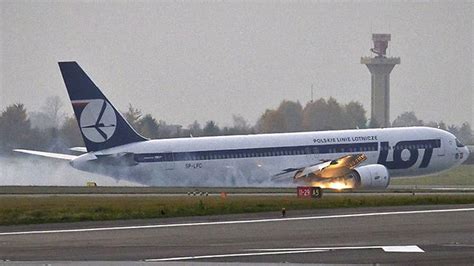
A harrowing incident involving an Air India Express flight IX-1344, operating from Dubai to Kozhikode (now known as Calicut) International Airport in Kerala, India, continues to reverberate, with newly surfaced footage providing a chilling visual account of the aftermath. The flight, which crash-landed on August 7, 2020, after overshooting the runway during a heavy monsoon rain, resulted in the tragic loss of at least 20 lives, including both pilots, and left scores injured. The released footage offers a stark reminder of the perilous conditions and the devastating impact of the crash.
The Air India Express Boeing 737-800, carrying 190 passengers and crew, was attempting to land at the tabletop runway of Kozhikode Airport, known for its challenging approach. The accident occurred when the aircraft, after an initial failed landing attempt, circled back and touched down far beyond the designated landing zone amid torrential rain and poor visibility. The plane then skidded off the runway, plunging into a 35-foot valley before splitting into two sections.
The newly emerged footage, reportedly filmed by first responders and local residents shortly after the crash, depicts a scene of chaos and devastation. Mangled debris of the aircraft is scattered across the crash site, with rescue workers and locals frantically working to extricate survivors from the wreckage. The visuals capture the sheer scale of the disaster and the immediate aftermath of the tragic event, highlighting the challenges faced by rescue teams in the difficult terrain and adverse weather conditions. Screams and cries for help pierce through the heavy rain, underscoring the urgency and gravity of the situation.
The crash immediately triggered a large-scale rescue operation involving local authorities, disaster management teams, and volunteers. Injured passengers were rushed to nearby hospitals, while efforts were focused on recovering the deceased and securing the crash site. The Air Accidents Investigation Bureau (AAIB) launched a formal investigation to determine the precise cause of the accident, examining factors such as weather conditions, pilot error, runway conditions, and aircraft maintenance.
The accident at Kozhikode Airport brought renewed scrutiny to the safety of tabletop runways, which are constructed on elevated terrain with steep drops at either end. These runways, common in mountainous regions and areas with limited space, pose unique challenges for pilots, particularly during adverse weather conditions. The incident prompted calls for enhanced safety measures and improved infrastructure at airports with tabletop runways to mitigate the risk of similar accidents in the future.
The AAIB investigation report, which was released later, pointed to a combination of factors contributing to the crash. The report cited the pilot’s decision to proceed with the landing despite the unfavorable weather conditions, the excessive speed of the aircraft during touchdown, and the delayed initiation of the go-around as key factors. The report also highlighted the challenges associated with landing on a wet tabletop runway with a tailwind.
The Air India Express crash at Kozhikode remains a somber reminder of the inherent risks associated with air travel and the importance of adhering to strict safety protocols. The newly surfaced footage serves as a powerful testament to the human cost of such accidents and underscores the need for continuous vigilance and improvement in aviation safety standards. The families of the victims continue to grapple with their loss, and the incident has left a lasting impact on the aviation community and the local community in Kerala.
Expanded Details and Context:
The Kozhikode air disaster not only caused immediate devastation but also initiated a broader discussion about aviation safety, particularly in the context of challenging airport environments. The airport itself, officially known as Calicut International Airport (CCJ), serves the Malabar region of Kerala, a state with a large diaspora working in the Gulf countries. The airport is vital for connecting expatriates with their families, which increases its traffic volume and operational significance.
Tabletop Runway Concerns:
The primary concern raised in the aftermath was the inherent risk associated with tabletop runways. Characterized by their location on hilltops or elevated terrains, these runways typically feature steep drops at both ends. This configuration reduces the margin for error during landing and takeoff, especially when compounded by adverse weather conditions such as heavy rain, strong winds, and poor visibility – all of which were present during the ill-fated landing.
Experts have long cautioned about the increased risk profile of such airports. The limited space for error means that any misjudgment in approach speed, descent rate, or touchdown point can quickly lead to a runway excursion, as tragically demonstrated in the Kozhikode crash. Previous incidents at other tabletop airports, both in India and globally, have underscored these vulnerabilities. For instance, the 2010 Air India Express crash in Mangalore, also a tabletop airport, shared similar characteristics with the Kozhikode accident, raising questions about the lessons learned from earlier tragedies.
Weather Conditions and Pilot Judgment:
The meteorological conditions prevailing at the time of the attempted landing played a crucial role in the sequence of events. The monsoon season in Kerala brings with it intense rainfall and fluctuating wind patterns. Pilots are trained to assess these conditions and make informed decisions regarding the feasibility of landing. The investigation report indicated that the pilots had attempted one landing and then initiated a go-around due to unfavorable conditions. The decision to attempt a second landing, despite the continued presence of heavy rain and a tailwind, came under scrutiny.
A tailwind, where the wind is blowing in the same direction as the aircraft’s movement, increases the landing distance required. This is because the aircraft’s ground speed is higher, requiring more runway to decelerate. On a tabletop runway with limited length, this factor becomes even more critical. The pilots’ judgment in proceeding with the landing under these conditions was a key aspect of the investigation.
Aircraft Condition and Maintenance:
While the investigation primarily focused on human factors and environmental conditions, the role of aircraft maintenance and condition was also examined. Although no major mechanical failures were identified, investigators meticulously reviewed the aircraft’s maintenance records to ensure compliance with safety standards and identify any potential contributing factors. The structural integrity of the Boeing 737-800 was also assessed to determine if it played any role in the severity of the crash.
Rescue Operations and Immediate Response:
The immediate aftermath of the crash was marked by a rapid and coordinated response from local authorities, disaster management teams, and local residents. Given the challenging terrain and adverse weather conditions, the rescue operation was a complex undertaking. The first responders faced significant obstacles in reaching the crash site, extricating survivors, and providing medical assistance. The local community played a crucial role in the rescue efforts, offering support and assistance to the emergency services.
Hospitals in Kozhikode and surrounding areas were quickly mobilized to treat the injured. The severity of the injuries ranged from minor cuts and bruises to critical trauma requiring immediate surgery. The medical response was coordinated to ensure that all injured passengers received timely and appropriate care. The psychological impact of the crash on survivors and their families was also recognized, and counseling services were provided to help them cope with the trauma.
Air Accidents Investigation Bureau (AAIB) Report Findings:
The AAIB’s investigation report provided a detailed analysis of the factors contributing to the crash. The report highlighted the following key findings:
-
Pilot Error: The report concluded that the pilot’s decision to continue with the landing despite the unfavorable weather conditions and the excessive speed of the aircraft during touchdown were major contributing factors. The delayed initiation of the go-around after the first landing attempt also played a role.
-
Weather Conditions: The heavy rain, poor visibility, and tailwind created challenging landing conditions. The pilots had to contend with reduced braking action and increased landing distance due to the wet runway.
-
Runway Conditions: The tabletop runway configuration and the presence of water on the runway surface increased the risk of a runway excursion.
-
Standard Operating Procedures (SOPs): The report also examined whether the airline’s standard operating procedures were adequate and whether the pilots had adhered to them. Any deviations from the SOPs were carefully scrutinized.
-
Training and Experience: The pilots’ training and experience were also assessed to determine if they were adequately prepared to handle the challenging landing conditions.
Safety Recommendations:
Based on its findings, the AAIB issued a series of safety recommendations aimed at preventing similar accidents in the future. These recommendations included:
-
Enhanced Training for Pilots: Improved training programs for pilots to handle adverse weather conditions and challenging runway environments.
-
Review of Standard Operating Procedures: A comprehensive review of airline SOPs to ensure they are aligned with best practices and address the specific risks associated with tabletop runways.
-
Runway Safety Enhancements: Implementation of runway safety enhancements, such as Engineered Material Arresting Systems (EMAS), to help decelerate aircraft that overshoot the runway.
-
Improved Weather Forecasting: Enhanced weather forecasting and reporting systems to provide pilots with accurate and timely information about weather conditions at the airport.
-
Aerodrome Safety Audits: Regular safety audits of airports with tabletop runways to identify and address potential hazards.
Engineered Material Arresting System (EMAS):
One of the key safety recommendations following the crash was the installation of Engineered Material Arresting Systems (EMAS) at airports with tabletop runways. EMAS is a special material placed at the end of a runway that is designed to collapse under the weight of an aircraft, providing a controlled deceleration and preventing the aircraft from overrunning into a drop-off or other hazard. While EMAS systems are expensive to install, they have proven to be effective in preventing accidents and mitigating the severity of runway excursions.
Impact on Aviation Safety Regulations:
The Kozhikode air disaster had a significant impact on aviation safety regulations in India and globally. The incident prompted a renewed focus on the safety of tabletop runways and the need for enhanced safety measures to mitigate the risks associated with these challenging environments. Aviation authorities around the world reviewed their safety protocols and implemented measures to improve the safety of air travel.
Compensation and Support for Victims’ Families:
Air India Express provided compensation to the families of the deceased and injured passengers. The amount of compensation varied depending on the severity of the injuries and the circumstances of the death. The airline also provided support and assistance to the families to help them cope with the aftermath of the crash.
Long-Term Psychological Impact:
The survivors of the Kozhikode air disaster and the families of the victims continue to grapple with the long-term psychological impact of the tragedy. Many survivors have experienced post-traumatic stress disorder (PTSD), anxiety, and depression. Counseling and support services are essential to help these individuals cope with their trauma and rebuild their lives.
Community Resilience:
Despite the devastation caused by the crash, the local community in Kozhikode demonstrated remarkable resilience and solidarity. The community came together to support the rescue efforts, provide assistance to the injured, and offer comfort to the families of the victims. The spirit of compassion and unity displayed by the community was a testament to the strength and resilience of the human spirit.
Future of Kozhikode Airport:
The Kozhikode airport remains a vital transportation hub for the Malabar region of Kerala. The airport authorities have implemented several safety enhancements in response to the AAIB’s recommendations, including improving runway friction, enhancing weather monitoring systems, and providing additional training for air traffic controllers. The airport continues to operate under strict safety guidelines to ensure the safety of passengers and crew. The possibility of expanding the airport and acquiring more land is still under consideration to improve the safety and operational efficiency of the airport.
The Air India Express crash at Kozhikode served as a stark reminder of the importance of aviation safety and the need for continuous vigilance and improvement. The lessons learned from this tragedy have led to enhanced safety measures, improved training, and a renewed focus on mitigating the risks associated with challenging airport environments. The aviation community must continue to prioritize safety to prevent similar accidents from occurring in the future. The memories of those who lost their lives in the crash will continue to inspire efforts to make air travel safer for all. The new footage, while distressing, serves as a crucial reminder of the human element in aviation safety, urging all stakeholders to maintain the highest standards and learn from past mistakes.
The Human Cost:
Beyond the technical details and safety recommendations, it is crucial to remember the human cost of the Kozhikode air disaster. The crash claimed the lives of 20 people, including two pilots. Each of these individuals had families, friends, and loved ones who were deeply affected by their loss. The survivors of the crash also suffered physical and emotional trauma that will likely have a lasting impact on their lives. It is essential to remember the human element of aviation safety and to ensure that every effort is made to prevent similar tragedies from occurring in the future. The names and stories of the victims should serve as a constant reminder of the importance of safety and the need to honor their memory by working tirelessly to improve air travel for all.
Long-Term Monitoring and Safety Culture:
The aviation industry operates in a dynamic environment with constant technological advancements and evolving operational procedures. To maintain a high level of safety, it is essential to have robust monitoring systems in place to identify potential hazards and address them proactively. This includes continuous monitoring of aircraft performance, weather conditions, pilot performance, and maintenance practices. A strong safety culture is also crucial, where all stakeholders are encouraged to report safety concerns without fear of reprisal. This culture of openness and transparency helps to identify and address potential problems before they can lead to accidents.
Role of Technology and Automation:
Technology and automation play an increasingly important role in aviation safety. Advanced flight management systems, enhanced weather radar, and automated landing systems can help pilots to navigate challenging conditions and make informed decisions. However, it is important to recognize that technology is not a panacea and that human factors remain a critical element of aviation safety. Pilots must be properly trained to use these technologies effectively and to maintain situational awareness in all phases of flight. Automation should be used to augment human capabilities, not to replace them entirely.
Global Collaboration and Information Sharing:
Aviation safety is a global concern that requires collaboration and information sharing among aviation authorities, airlines, manufacturers, and research institutions around the world. By sharing data and best practices, the aviation community can identify common safety issues and develop effective solutions. International organizations such as the International Civil Aviation Organization (ICAO) play a vital role in coordinating these efforts and setting global standards for aviation safety. Regular conferences, workshops, and training programs provide opportunities for aviation professionals to exchange knowledge and learn from each other’s experiences.
The rewritten article aims to provide a comprehensive overview of the Air India Express crash at Kozhikode, including the circumstances of the accident, the findings of the investigation, the safety recommendations that were implemented, and the long-term impact on aviation safety. By highlighting the human cost of the tragedy and the importance of continuous improvement, the article seeks to promote a culture of safety and prevent similar accidents from occurring in the future. The addition of the newly surfaced footage serves as a powerful reminder of the need for vigilance and the importance of learning from past mistakes.
Frequently Asked Questions (FAQ):
-
What caused the Air India Express flight IX-1344 to crash in Kozhikode?
The Air Accidents Investigation Bureau (AAIB) report cited a combination of factors, including the pilot’s decision to proceed with landing despite unfavorable weather conditions (heavy rain, poor visibility, tailwind), excessive speed during touchdown, and a delayed go-around initiation. The challenging conditions of the tabletop runway and its wet surface also contributed. The report clearly stated that pilot error along with existing challenging runway conditions are the primary causes.
-
What is a tabletop runway, and why are they considered more dangerous?
A tabletop runway is built on an elevated terrain or plateau, featuring steep drop-offs at either end. This design leaves little margin for error during landing or takeoff. If an aircraft overshoots or undershoots the runway, there’s a higher risk of a catastrophic accident due to the steep drop-offs.
-
What safety measures have been implemented at Kozhikode Airport since the crash?
Following the AAIB’s recommendations, Kozhikode Airport has implemented several safety enhancements, including improving runway friction, enhancing weather monitoring systems, and providing additional training for air traffic controllers and pilots. There has also been discussion regarding the installation of an Engineered Material Arresting System (EMAS), though challenges regarding land acquisition remain.
-
What is the significance of the newly surfaced footage from the crash site?
The footage provides a stark and visual representation of the immediate aftermath of the crash, highlighting the devastation, the challenges faced by rescue workers, and the human cost of the tragedy. It serves as a powerful reminder of the importance of aviation safety and the need for continuous vigilance. The footage reinforces the seriousness of the event and underscores the responsibility of all parties involved in air travel to prioritize safety.
-
What compensation was provided to the victims and their families?
Air India Express provided compensation to the families of the deceased and injured passengers. The amount varied depending on the severity of the injuries and the circumstances of the death, adhering to established aviation compensation norms. Support and assistance were also offered to help families cope with the aftermath. While the exact figures vary, the compensation generally included provisions for medical expenses, loss of income, and bereavement.









